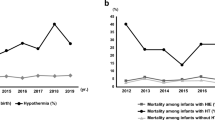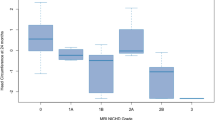Abstract
OBJECTIVE:
To determine early predictors of abnormal outcome at ≥24 months' age in neonates at risk for hypoxic–ischemic brain injury.
STUDY DESIGN:
A prospective cohort study with developmental follow-up of ≥24 months. Infants were selected based on risk factors, and neurologic outcome was determined. Variables affecting the outcome were evaluated with univariate and multivariate methods, and a scoring system was devised to predict adverse outcome.
RESULTS:
A total of 41 infants born ≥35 weeks' gestational age with possibility of hypoxic–ischemic insult were enrolled. In all, 39 (95%) had known outcomes, of whom 17 (48%) had an abnormal neurologic outcome, including five deaths. The variables within the first hour of life correlating with the adverse outcome were 1- and 5-minute Apgar scores, intubation in the delivery room and cord/initial base-deficit ≥20 mmol/l. A scoring system was derived based on significant variables, and a score ≥5 had a 90% positive predictive value for abnormal outcome. Seizures, multiorgan failure and abnormal imaging studies were also significantly associated with abnormal outcome.
CONCLUSIONS:
The proposed scoring system, being highly predictive of outcome at 24 months' age, may be potentially useful in selecting subjects for preventive or therapeutic interventions to prevent or minimize neurologic morbidity due to hypoxic brain injury.
This is a preview of subscription content, access via your institution
Access options
Subscribe to this journal
Receive 12 print issues and online access
$259.00 per year
only $21.58 per issue
Buy this article
- Purchase on Springer Link
- Instant access to full article PDF
Prices may be subject to local taxes which are calculated during checkout
Similar content being viewed by others
References
Patel J, Edwards AD . Prediction of outcome after perinatal asphyxia. Opin Pediatr 1997;9:128–132.
Perlman JM . Intrapartum hypoxic–ischemic cerebral injury and subsequent cerebral palsy: medico-legal issues. Pediatrics 1997;99:851–859.
Mutch L, Alberman E, Hagberg B, Kodoma K, Perat M . Cerebral palsy epidemiology: where are we now and where are we going? Dev Med Child Neurol 1992;34:547–555.
Vannucci RC, Perlman JM . Interventions of perinatal hypoxic–ischemic encephalopathy. Pediatrics 1997;100:1–11.
Van Bel F, Shadid M, Moison RMW, et al. Effects of allopurinol on postasphyxial free radical formation, cerebral hemodynamics, and electrical brain activity. Pediatrics 1998;101:185–193.
Hall RT, Hal FK, Daily DK . High-dose phenobarbital therapy in term newborn infants with severe perinatal asphyxia: a randomized prospective study with a three-year follow-up. J Pediatr 1998;132:345–348.
Levene M, Blennow M, Whitelaw A, Hanko E, Fellman V, Hartley R . Acute effects of two different doses of magnesium sulphate in infants with birth asphyxia. Arch Dis Child 1995;73:F174–F177.
King TA, Jackson GL, Jossey S, et al. The effect of profound umbilical artery acidemia in term neonates admitted to a newborn nursery. J Pediatr 1998;132:624–629.
Van den Berg PP, Nelen W, Jongsma HW, et al. Neonatal complications in newborns with umbilical artery pH<7.00. Am J Obstet Gynecol 1996;175:1152–1157.
Low JA, Panagiotopoulos C, Derrick JE . Newborn complications after intrapartum asphyxia with metabolic acidosis in the term fetus. Am J Obstet Gynecol 1994;17:1081–1087.
Fee SC, Malee K, Deddish R, Minogue JP, Socol ML . Severe acidosis and subsequent neurologic status. Am J Obstet Gynecol 1990;162:802–806.
Nelson KB, Ellenberg JH . Apgar scores as predictors of chronic neurologic disability. Pediatrics 1981;68:36–44.
Silverman F, Suidan J, Wassermann J, Antoine C, Young BK . The Apgar score: is it enough? Obstet Gynecol 1985;66:331–336.
Low JA, Simpson LL, Tonni G, Chamberlain S . Limitations in the clinical prediction of intrapartum fetal asphyxia. Am J Obstet Gynecol 1995;172:801–804.
Lein JM, Towers CV, Quilligan EJ, Veciana M, Toohey JS, Morgan MA . Term early-onset neonatal seizures: obstetric characteristics, etiologic classifications, and perinatal care. Obstet Gynecol 1995;85:163–169.
Phelan JP, Ahn MO, Korst LM, Martin GI . Nucleated red blood cells: a marker for fetal asphyxia? Am J Obstet Gynecol 1995;173:1380–1384.
Ruth V, Autti-Ramo I, Granstorm M, Korkman M, Raivio KO . Prediction of perinatal brain damage by cord plasma vasopressin, erythropoetin, and hypoxanthine values. J Pediatr 1988;113:880–885.
Hollander DI, Wright L, Nagey DA, Wright JN, Pupkin MJ, Koch T . Indicators of perinatal asphyxia. Am J Obstet Gynecol 1987;157:839–843.
Westas-Hellstrom L, Rosen I, Svenningsen NW . Predictive value of early continuous amplitude integrated EEG recordings on outcome after severe birth asphyxia in full term infants. Arch Dis Child 1995;72:F34–F38.
Eken P, Toet MC, Groenendaal F, De Vries LS . Predictive value of early neuroimaging, pulsed Doppler and neurophysiology in full term infants with hypoxic–ischemic encephalopathy. Arch Dis Child 1995;73:F75–F80.
Portman RJ, Carter BS, Gaylord MS, Murphy MG, Theime RE, Merenstein GB . Predicting neonatal morbidity after perinatal asphyxia: a scoring system. Am J Obstet Gynecol 1990;162:174–182.
Carter BS, McNabb F, Merenstein GB . Prospective validation of a scoring system for predicting neonatal morbidity after acute perinatal asphyxia. J Pediatr 1998;132:619–623.
Gunn AJ, Bennet L, Gunning MI, Gluckman PD, Gunn TR . Cerebral hypothermia is not neuroprotective when started after postischemic seizures in fetal sheep. Pediatr Res 1999;46(3):274–280.
Gunn AJ, Gunn TR, de Hann HH, Williams CE, Gluckman PD . Dramatic neuronal rescue with prolonged selective head cooling after ischemia in fetal lambs. J Clin Invest 1997;99(2):248–256.
American Academy of Pediatrics, American College of Obstetricians and Gynecologists. Relationships between perinatal factors and neurologic outcome. In: Hauth JC, Merenstein GB, editors. Guidelines for Perinatal Care. 4th edn. Elk Grove Village, IL: American Academy of Pediatrics; 1997. p 122–123.
Sarnat HB, Sarnat MS . Neonatal encephalopathy following fetal distress. Arch Neurol 1976;33:696–705.
Capute AJ, Shapiro BK . The motor quotient. A method for the early detection of motor delay. Am J Dis Child 1985;139:940–942.
Blasco PA . Normal and abnormal development. Pediatr Rounds 1992;1:1–6.
Venables WN, Ripley BD, editors. Modern Applied Statistics with S-plus, 2nd ed. New York: Springer Verlag, Inc.; 1997. p. 413–430.
Robertson C, Finer N . Term infants with hypoxic–ischemic encephalopathy: outcome at 3.5 years. Dev Med Child Neurol. 1985;27:473–484.
Shankaran S, Woldt E, Koepke T, Bedard MP, Nandayal R . Acute neonatal morbidity and long-term central nervous system sequelae of perinatal asphyxia in term infants. Early Hum Dev 1991;25:135–148.
Ekert P, Perlman M, Steinlin M, Hao Y . Predicting the outcome of post-asphyxial hypoxic–ischemic encephalopathy within 4 hours of birth. J Pediatr 1997;131:613–617.
Martin-Ancel A, Alix-Garcia A, Gaya F, Cabanas F, Burgueros M, Quero J . Multi-organ involvement in perinatal asphyxia. J Pediatr 1995;127:786–793.
Perlman JM, Tack ED, Martin T, Shackelford G, Amon E . Acute systemic organ injury in term infants after asphyxia. Am J Dis Child 1989;143:617–620.
Perlman JM, Tack ED . Renal injury in the asphyxiated newborn infant: relationship to neurologic outcome. J Pediatr 1988;113:875–879.
Perlman JM, Risser R . Can asphyxiated infants at high risk for neonatal seizures be rapidly identified by current high-risk markers? Pediatrics 1996;97:456–462.
Barkovich AJ, Hajnal BL, Vigneron D, et al. Prediction of neuromotor outcome in perinatal asphyxia: evaluation of MR scoring systems. Am J Neuroradiol R 1998;19:143–149.
Hankins GD, Speer M . Defining the pathogenesis and pathophysiology of neonatal encephalopathy and cerebral palsy. Obstet Gynecol 2003;102:628–636.
American College of Obstetricians and Gynecologists' Task Force Report on Neonatal Encephalopathy and Cerebral Palsy, American College of Obstetrics and Gynecologists, American Academy of Pediatrics. Neonatal Encephalopathy and Cerebral Palsy: Defining Pathogenesis and Pathophysiology. 2003.
Author information
Authors and Affiliations
Rights and permissions
About this article
Cite this article
Talati, A., Yang, W., Yolton, K. et al. Combination of Early Perinatal Factors to Identify Near-Term and Term Neonates for Neuroprotection. J Perinatol 25, 245–250 (2005). https://doi.org/10.1038/sj.jp.7211259
Published:
Issue Date:
DOI: https://doi.org/10.1038/sj.jp.7211259
This article is cited by
-
Predicting outcome in term neonates with hypoxic-ischaemic encephalopathy using simplified MR criteria
Pediatric Radiology (2005)



